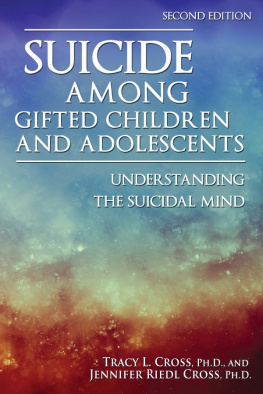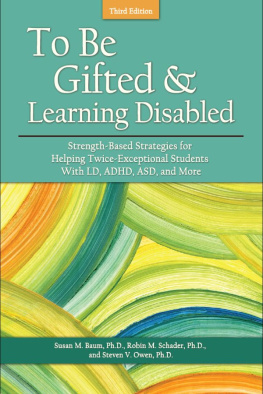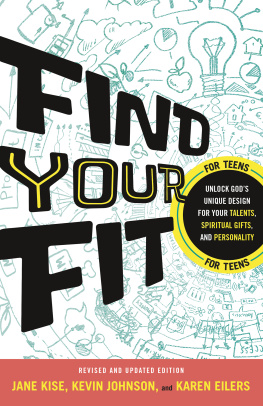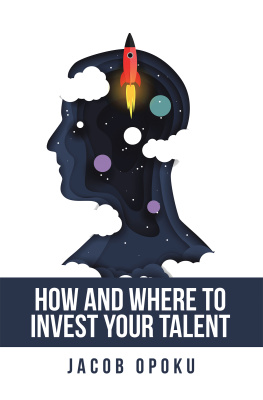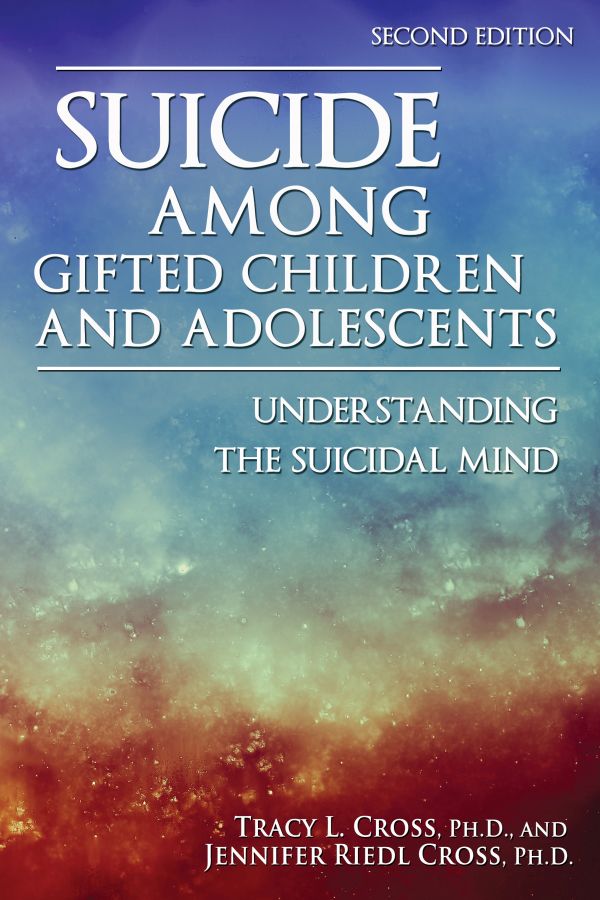


ACKNOWLEDGEMENTS
Several people helped in creating this book. We would like to thank Lindsay Adams for her work, especially on updating the resources, and Natalie Dudnytska for her assistance with the chapter summaries. Thank you also to Lacy Compton for her work editing this book.
We also thank Joel McIntosh for supporting this project, knowing that it would likely appeal to a relatively small readership.
DEDICATION
This book is dedicated to Ben and his familyRoger, Sherry, and Amanda.
Copyright 2018, Prufrock Press Inc.
Edited by Lacy Compton
Cover and layout design by Allegra Denbo
ISBN-13: 978-1-61821-679-3
No part of this book may be reproduced, translated, stored in a retrieval system, or transmitted, in any form or by any means, electronic, mechanical, photocopying, microfilming, recording, or otherwise, without written permission from the publisher.
For more information about our copyright policy or to request reprint permissions, visit http://www.prufrock.com/permissions.
At the time of this books publication, all facts and figures cited are the most current available. All telephone numbers, addresses, and website URLs are accurate and active. All publications, organizations, websites, and other resources exist as described in the book, and all have been verified. The author and Prufrock Press Inc. make no warranty or guarantee concerning the information and materials given out by organizations or content found at websites, and we are not responsible for any changes that occur after this books publication. If you find an error, please contact Prufrock Press Inc.

| Prufrock Press Inc.
P.O. Box 8813
Waco, TX 76714-8813
Phone: (800) 998-2208
Fax: (800) 240-0333
http://www.prufrock.com |
TABLE OF CONTENTS
FOREWORD TO THE FIRST EDITION
I am pleased to provide a few words regarding Tracy Crosss unique contribution, Suicide Among Gifted Children and Adolescents. This book provides necessary information regarding the prevalence of the act itself, the risk factors associated with it, and helpful ideas on how schools can attempt to modify or eliminate this scourge.
Dr. Cross points out that Clearly suicide is commonplace, pervasive in our society, and preventable. Because there is a multitude of evidence presented in this volume to verify that statement, we might reflect on why it is so rarely a topic considered in our schools and journals. The myth that suicide is a sudden event that occurs out of nowhere and is unpredictable maintains itself despite its falsity. Can it be that such a belief relieves all of us of responsibility to take action on this devastating problem? We are fortunate that Dr. Cross has collected this impressive data that calls on all of us to pay attention and act.
One of the useful discoveries from the data is the age most at risk. Adolescence appears to be the most vulnerable age, much more so than later college-age students. Apparently, many adolescents have not been able to develop positive coping skills to deal with the depression and social problems often attendant to that age and conclude from their hopelessness that ending things is the only answer.
The greater prevalence of suicide in states with higher rates of gun ownership is an interesting fact. Apparently, access to a reliable tool may be the final factor in the recipe, because guns are much more reliable than poisons or knives to the person who has decided to act upon his or her despair.
The fact that suicide is no more prevalent among students with gifts and talents than among students with average abilities should not be seen as reassuring. In practically all other dimensions, being gifted is associated with positive factors such as greater health, friendships, etc. When such children prove just as vulnerable, that is proof again that it is personal ideation rather than reality that we are dealing with. Such children are as prone to depression and social isolation as other students.
In addition to the inevitable depression and despair among family and friends, we have a sense of loss of their special gifts: the sonata never written, the scientific cure never discovered, the political accomplishments never realized, the brilliant poetry never created. We can ill afford such loss of potential talent.
Crosss recommendation for schools are well advised. Both formal and informal screening of students should take place to identify early students at risk and to take positive action. Substitute behaviors can be encouraged, and positive behavior supports can be applied. A mental health committee to develop positive plans for individuals may operate similar to the Individualized Education Programs (IEPs) already in force and could be very helpful.
Also, the final section on national and state resources provides a good reference base for those looking for often-hard-to-find sources of information on this topic.
Dr. Cross has done his field, and all those who work in it, a valuable service in producing this volume. I believe it will be a much-quoted source for many years.
James J. Gallagher
University of North Carolina
Dr. James J. Gallagher passed away on January 17, 2014. Because he was such a staunch supporter of our research, with permission, we have included Dr. Gallaghers foreword from the first edition of the book.
PREFACE
TRACY L. CROSS
Although I have been somewhat aware of suicide since childhood, I have not been preoccupied with it or even particularly focused on it. I suspect that my longstanding interest in music and art have kept me close to people in two arenas wherein suicidal behavior has higher prevalence rates than average (Ludwig, 1995). I have also had numerous friends and acquaintances from the LGBTQ community, another group at higher than average risk for suicidal behavior. The single thread across my life is that I grew up surrounded by gifted and talented people. As I matured, I worried about some of my friends and acquaintances, as, occasionally, one would engage in suicidal ideation or make a suicide attempt. These experiences set the stage for my midcareer focus on the suicidal behavior of students with gifts and talents.
In April of 1994, while I was watching MTV News, I learned of the suicide of the alternative band Nirvanas singer-songwriter Kurt Cobain. I realized that we had lost an important musician and leader of disenfranchised youth. I feared that there would likely be a pronounced effect on the Cobain followers. For several months prior to Cobains death, I had been involved in a yearlong evaluation of a residential high school for intellectually gifted students (Academy). Within a couple of weeks of Cobains death, I was contacted by the dean of the college of education that administered the Academy and was apprised that it was prom night and there had been a suicide within the schools student body. I also learned that the suicide had occurred one block away from the Academys campus. I met the dean at the Academy to help, prior to his informing the students what had happened. The dean had the very difficult responsibility of telling the students, during their prom, about the suicide of one of their popular student leaders.
Next page
